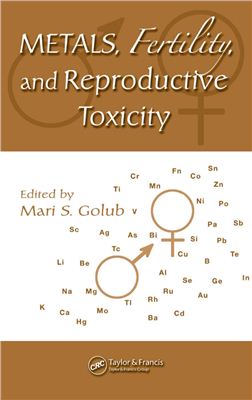CRC Press, Taylor & Francis Group, 2006, ISBN: 041570040X, 264
pages
Environmental endocrine disruptors have been at the heart of discussions about chemicals and their effects on fertility, but the focus has been on organic compounds and the role of metals has been largely overlooked - until now. Taking an organ-system-based approach, Metals, Fertility, and Reproductive Toxicity examines the effects of metals found in the everyday environment on fertility rates in humans and animal populations. This volume summarizes and evaluates the literature in the area of metal effects on fertility and reproduction in humans, laboratory animals, and wildlife. Inteational experts have contributed chapters that explore how the ovary, testes, uterine system, and neuroendocrine system, among others, respond to metal exposure. Reviewing both current knowledge and cutting edge data, the chapters focus on either a particular metal or a particular population. A massive amount of data on this subject has been generated, summarized, and reviewed over the years. While there are many books available on metals toxicity and on reproductive toxicity, no current book explores both in the same volume. Culling information from throughout the literature, Metals, Fertility, and Reproductive Toxicity supplies an in-depth look at the role of metals in endocrine disruption and the spectrum of mechanisms involving metals that can influence reproduction.
Reproductive Toxicity of Mercury, Cadmium, and Arsenic
Reproductive and Developmental Toxicity of Organotin Compound
Adverse Effects of Aluminum, Uranium, and Vanadium on Reproduction and Intrauterine Development in Mammals
Intrauterine and Reproductive Toxicity of Nutritionally Essential Metals
Lead Exposure and Its Effects on the Reproductive System
Impact of Metals on Ovarian Function
Epidemiological and Occupational Studies of Metals in Male Reproductive Toxicity
Use of Metal Reproductive Toxicity Data in Selecting Ecological Toxicity Reference Values for Small Mammals Inhabiting Hazardous Waste Sites
Environmental endocrine disruptors have been at the heart of discussions about chemicals and their effects on fertility, but the focus has been on organic compounds and the role of metals has been largely overlooked - until now. Taking an organ-system-based approach, Metals, Fertility, and Reproductive Toxicity examines the effects of metals found in the everyday environment on fertility rates in humans and animal populations. This volume summarizes and evaluates the literature in the area of metal effects on fertility and reproduction in humans, laboratory animals, and wildlife. Inteational experts have contributed chapters that explore how the ovary, testes, uterine system, and neuroendocrine system, among others, respond to metal exposure. Reviewing both current knowledge and cutting edge data, the chapters focus on either a particular metal or a particular population. A massive amount of data on this subject has been generated, summarized, and reviewed over the years. While there are many books available on metals toxicity and on reproductive toxicity, no current book explores both in the same volume. Culling information from throughout the literature, Metals, Fertility, and Reproductive Toxicity supplies an in-depth look at the role of metals in endocrine disruption and the spectrum of mechanisms involving metals that can influence reproduction.
Reproductive Toxicity of Mercury, Cadmium, and Arsenic
Reproductive and Developmental Toxicity of Organotin Compound
Adverse Effects of Aluminum, Uranium, and Vanadium on Reproduction and Intrauterine Development in Mammals
Intrauterine and Reproductive Toxicity of Nutritionally Essential Metals
Lead Exposure and Its Effects on the Reproductive System
Impact of Metals on Ovarian Function
Epidemiological and Occupational Studies of Metals in Male Reproductive Toxicity
Use of Metal Reproductive Toxicity Data in Selecting Ecological Toxicity Reference Values for Small Mammals Inhabiting Hazardous Waste Sites

